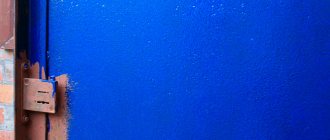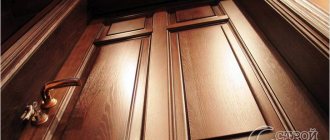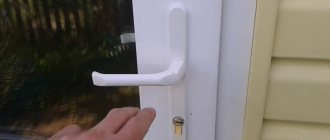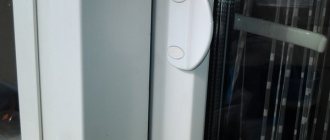Warmth and comfort in the house are the main tasks facing every owner of his own living space. Particular attention is paid to the front door, as it is in direct contact with the street. And in the cold season, heat can leave the room through the doorway. To avoid unpleasant consequences, you should insulate the front door. You can do this work yourself. But before you insulate a wooden door in a private house, you should prepare everything necessary for this.
Why insulate doors?
That is why carrying out work on insulating a door in a private house or other place can significantly reduce the wear time of the entire structure, that is, increase the service life of the entire structure as a whole. If the door was initially installed without insulation elements, the easiest way is to replace it with a new, more advanced model.
But the wear and tear of the insulation is felt immediately with the arrival of the cold season, as warm air quietly seeps through the formed slot passages between the door frame body and the door leaf itself.
Cutting and laying insulation
The next stage of insulating the door leaf will be laying material that will make it warmer . To do this, you need to arm yourself with a stationery knife. Thermal insulation is cut to the length and width of the sheet so that there is no empty space left. If the door is a frame with voids, then they need to be filled with insulation.
The insulation is tightly inserted between the bars
All pieces must be tightly inserted between the bars to prevent the formation of cold bridges. At the same time, the material should not bubble, which would indicate an excessively large supply. In this case, it is worth cutting off a little excess material. Once everything is adjusted, you need to secure the insulation with staples. A construction stapler allows you to do this quickly and efficiently.
Options for insulating entrance doors
The insulation of the wooden entrance door structure itself can be done in this way:
- Use mounting tape to remove the gap after the old foam has been removed;
- Check if the door structure has sagged as far as possible. If the fittings are faulty, then there is a need to replace the screws or the entire fittings;
- Reprocess the door that does not close using a plane. In this case, the excess surface is removed from the ends;
- Fix the seal so that it is located around the entire perimeter of the box, closer to the outside. Seals are mainly produced on an adhesive base, and it can be further strengthened with a stapler.
In the case of not very large gaps, a groove is simply cut, running along the entire perimeter to a depth of one or two millimeters. Its width should be three or four millimeters.
Door frame seal
If the canvas fits tightly to the box, no draft is scary. But cold air can enter the room through cracks , which are formed as a result of a loose connection to the opening trim. To close these gaps, a rubber profile is glued around the perimeter of the box. The work does not require professional knowledge, skills or additional costs. This sealant is produced on a ready-made sticky base.
You can replace the rubber seal with a leatherette tape. Fold the material in several layers and nail it to the wooden structure box with small nails. There may be gaps between the frame and the doors, even if they are of good quality.
Insulation with dermantine
When the door itself allows air to pass through, it can be additionally equipped with one of the materials to improve the thermal insulation properties:
- Sintepon;
- Foam rubber;
- Penoizol;
- Isolon.
The last two materials deteriorate less, since they absorb moisture in much smaller quantities, especially if they are additionally covered with a metallized film.
For external insulation use:
- Leatherette (quite rare);
- Eco leather;
- Vinyl;
- Dermantin.
When choosing the last option, work is carried out in the following sequence:
- Installation of rollers, in which the material is shot with a stapler, while the backside remains on top and runs along the entire edge of the door;
- The device of the roller, made using a special material - foam rubber, must be installed in the prepared strip;
- If there is such a need, then the excess near the hinges is cut off, then nothing will interfere with the canvas opening and closing;
- All that remains is to re-attach the dermantine strips in the places adjacent to the door leaf;
- After making sure that the roller devices are ready, the insulating base is reattached to the door surface;
At the final stage, dermantin is fixed on top of the insulating layer, starting from the very center, so that there are no folds or distortions. Then the material must be precisely secured at the top and bottom to avoid sagging and nailed along the entire edge;
Make holes where both the lock and handles will be inserted. The door is decorated with fishing line or upholstery nails.
Preparatory work
To insulate the door leaf, you should go step by step, stage by stage. This approach allows you to achieve good results and eliminate errors. And first there is preparatory work to be done.
To ensure that nothing interferes with the work, you need to remove the door leaf. This is done using a mounting tool or a nail puller . It is enough to pry the canvas from below and it will rise from its hinges. If the rotary axis is slightly rusty, then it must be lubricated with machine oil. After this, with small forward movements you can move the hinge and remove the door leaf.
When the door is outside the frame, all existing elements must be removed from it. The hinges, handles, peephole and lock are carefully unscrewed and put aside. If the door is not made only of wood, then it is necessary to remove the sheet of inner lining to gain access to the interior of the door leaf.
Insulation of a metal door
Metal structures are insulated mainly from the inside, but such finishing can also be done in the front part of the canvas.
To insulate metal door structures, one of the following options is usually chosen:
- Using mineral-based cotton wool, which retains heat well. It contains absolutely no toxins. If the entrance is heated well, then this is the best option for a door at the entrance. Among the disadvantages, it is worth noting poor resistance to moisture, the reason why the cotton wool, having compacted, rushes downwards;
- Finishing with polystyrene material or foam is a great idea. In this case, the side of the door from the street becomes more resistant to humidity and temperature fluctuations. But its combustion releases a lot of substances harmful to the human body.
Installation of double doors
A good way to insulate your home is to install a double entry door. Due to the formation of an air space separating the room from the street, heat is retained. The disadvantage of this design is the reduction in space.
A threshold is set for the indoor unit. Insulation is additionally laid on the slopes between the doors. There are designs where two doors are hinged on one deep frame.
When insulating entrance doors, you must remember that moisture affects the canvas from the street side. Treatment with impregnation, painting with paint or varnish will help protect against dampness as much as possible. Drying oil creates good waterproofing.
Insulation process
Work order:
- The dimensions of the cells are measured, and then the pieces of insulation that are necessary are cut out from them. In the case of not provided “ribs” to impart rigidity to the structure, the cells are made with self-tapping screws and wooden blocks;
- The insulation is fixed in place. To do this, use either polyurethane foam or glue. Additionally, foaming of joints is carried out;
- When the door leaf is insulated, it is covered with a decorated panel made of any suitable material. For example, plastic, plywood, chipboard, etc. it is usually attached to a metal frame using self-tapping screws.
Insulation of a wooden structure with foam plastic
The work begins with the need to cut a sheet of foam strictly along the perimeter of the door. If insulation is carried out from the inside, then it is necessary to cut the foam sheet according to the clearance of the box. The cut out part is covered with artificial leather and glued to a wooden panel with liquid nails.
You can use another option for foam insulation. Nail wooden slats of the same thickness with foam around the perimeter. Place insulation between them. Cover it with natural wood material. It is also called “lining”. You can also use laminated fiberboard for cladding. As a result, the structure will become heavier than before. Therefore, to strengthen it, additional loops will be required.
Cable for insulating doorways
This method of insulating a metal street door is considered the most effective. This is especially true for its use in a garage, in a country house, and also, of course, in a private home.
The use of electric cable for these purposes is fully justified by its specific qualities. It eliminates the most unpleasant problem - the accumulation of unnecessary condensation.
To operate, you need to purchase a cable with one heating core. At the same time, ten to eleven meters will be quite enough to cover the entire contour of the door frame with it, also using the threshold.
Warming is carried out in stages:
- The space on the floor and the floor of the door frame is completely cleared, that is, the layer of plaster is removed, the previous foam for installation is cut out, and the floor tiles are dismantled;
- The free part of the space must be filled with tile adhesive to create a warm installed floor. To do this, you should initially recess the electrical cable, starting work from the corner below. After which a certain number of turns are made at the very threshold, so as to place the temperature sensor between the turns of the cable;
- The system should now be connected to the general electrical network of the house. It is best to use the services of an electrician for such work. The two ends of the cable are inserted into the two cable ends along with the temperature sensor wire.
Sealing wooden door openings using rollers
This method is suitable if it is not possible to remove the door from its hinges. For example, winter has come and severe frosts along with it. Thus, in order to maximize the thermal insulation properties of a wooden entrance door, rollers are used. They are nailed directly to the door frame. To obtain a positive and correct result, it is necessary to accurately determine the position of the roller. The closed door should be in tight contact with it.
The roller should be nailed not to the threshold, but to the box. Otherwise, it will simply become unusable. The best option would be to attach it to the bottom end of the door.
Photo of door insulation
Criteria for choosing building materials
If you carry out insulation yourself, it is preferable to purchase a self-adhesive version. Craftsmen advise having foam rubber or felt available. Using them is not difficult. A sash equipped with this gasket can be closed without any effort. The sealing material – rubber is characterized by high wear resistance.
Soft rectangular, tubular rubber seals are also in demand. Their service life is 5-7 years. They protect the room from odors and extraneous noise. The thermoplastic-based profile is resistant to temperature changes.
Craftsmen focus on the choice of filler for insulating the sash and the space around the frame. This process must be conscious, since it is difficult to change them. When choosing, you need to pay attention to the thermal conductivity coefficient. It determines how the material will handle heat retention. For wooden products, thin fillers are a good option. The use of soft insulation greatly simplifies the work. Its advantage is that it covers the surface with a margin and shrinks as much as necessary. It is important to measure the thickness and dimensions of individual structural elements with increased accuracy.
Sheathing
Instead of insulating building material, you can sheathe the structure with dermantine. This is relevant when insulating a room from the outside. The work is carried out following a certain sequence. Upon completion, you can make the following design:
- as functional as possible;
- stylish;
- attractive.
The sheathing is laid on top of the insulation. In this regard, you can use genuine leather or dermantine. The material needs to be laid on the door leaf and the edges folded. It is attached to it with a stapler.
Builders recommend watching closely to ensure that the building material does not sag. This will prevent it from moving. To avoid such troubles, you need to start fastening the upholstery from the center and gradually move towards its edges. At the end of the work, you need to secure the curved edges of the upholstery. Holes of appropriate sizes should be cut in the areas where the lock is located.
After completion of the repair work, all fittings are installed in their places. Installation of an insulated door is carried out at the place of its use. The completed work will be the key to a beautiful and warm door.
Interesting: How to make a lightning rod in a private house
Table of thermal insulation properties of materials
| Material | Density in kg/m3 | Minimum layer, cm | Thermal conductivity | Hygroscopicity | |
| Roll | Glass wool | 75-175 | 10-15 | G | B |
| Minvata | 35-125 | 10-15 | G | B | |
| Stitched mats | 75-150 | 10-15 | G | B | |
| Plastif | 50-60 | 2 | G | D | |
| Izover, URSA | 35-125 | 10-15 | G | B | |
| Penofol | 60-70 | 5 | G | IN | |
| Expanded polystyrene | 30-40 | 10 | D | IN | |
| Polyurethane foam | 30-60 | 10 | D | IN | |
| Plate-sheet | Styrofoam | 35-50 | 10 | D | IN |
| Mipora | 25-40 | 10 | D | IN | |
| From mineral wool and glass wool | 75-250 | 10-15 | G | B | |
| Woody-fibrous | 250 | 1.5-3 | B | A |
Legend:
- A - Very high.
- B - High.
- B - Average.
- G - Low.
- D - Very low.
Today, several methods of insulation are possible. You can:
- secure the seal to the box;
- upholster the canvas with insulation;
- seal the opening using rollers.
Let's take a closer look at each of the options.
Where and how to use insulation with foil?!
We have previously told you about how to properly use this insulation; you can find out more about this here
What kind of insulation can be used
To insulate a wooden door yourself, it is important to choose the right material for thermal insulation and decorative finishing. The cracks must be sealed with sealant.
What material is best to use for insulation? The most effective options include:
- Polystyrene foam is best used as internal insulation for entrance doors. The structure should be covered with slabs from the side of the room.
- Foam rubber is considered the most common insulation material. It needs to be covered with a leather substitute on top. This porous material helps to obtain the required volume. However, over time, it loses its properties and begins to crumble.
- Mineral wool is considered a non-flammable material that has excellent thermal insulation characteristics. The downside of the substance is that it cakes quickly. In conditions of severe dampness, mineral wool can quickly accumulate moisture. Under its own weight, it literally slides off a vertical surface. Therefore, it is not worth using such material for baths.
- Foamed polyethylene - called isolon. The structure of the substance is similar to foam rubber. However, it is characterized by better thermal insulation characteristics and a longer service life. Izolon can hardly withstand prolonged exposure to direct sunlight.
- Polyurethane foam - applied by spraying. It can be firmly glued to the wood. In addition, the substance easily gets into any cracks. The disadvantage of the material is the need to use special devices.
- Expanded polystyrene is similar to polystyrene foam, but has improved properties. When exposed to open fire, the material itself extinguishes.
- Felt has a high degree of wear resistance and a long service life. Another advantage of the material is good sound insulation.
When choosing insulation, you should take into account the thickness of the material. Too thick structures lead to weighting of the sashes, and thin ones do not give the desired effect.
You can use polystyrene foam to insulate the door.
Liquid insulation for doors - is it suitable or not?
Liquid ceramic thermal insulation is a relatively modern product; it is used to insulate apartment buildings, and even heating mains! But what is it? And can it be used for your own purposes, for example, by insulating the front door? Let's figure it out.
Liquid ceramic insulation is the so-called sodium borosilicate mixed with polymers. Under a microscope this sodium borosilicate looks like very small hollow balls, but to us this insulation just looks like white paint.
This is what a pipe painted with liquid ceramic thermal insulation looks like
Is it really possible to just paint the door and forget about the cold and freezing? Of course not. After all, in essence, liquid ceramic thermal insulation is just simple paint with slightly enhanced thermal protection. It practically does not protect against the cold and is objectively bad for almost any type of thermal insulation. They can be used, perhaps, to reflect solar radiation and in some places where it is necessary to protect people from accidental burns from pipes (for example, in boiler rooms).
We can say for sure that liquid insulation will definitely not be effective enough either for insulating facades or for insulating walls, floors, windows and doors.
Specialists who were skeptical about such materials conducted an experiment with these thermal paints from different manufacturers, and the thermal conductivity coefficient was only 0.053-0.082 W/m*K! This is two to three times worse than any of the above material.
If all the calculations are made, then in order for liquid ceramic thermal insulation to achieve the same thermal conductivity effect as a piece of foam plastic 5 cm thick, it is necessary to apply this paint in as many as 190 layers! Needless to say, this is a waste of time and money?
Thus, what you should definitely avoid when insulating a door (or anything at all) is the use of liquid insulation.
Tools and materials
In addition to insulation - the main material, you also need fasteners, cladding, etc.
Polymer seal for entrance door
Table 1. All necessary materials and tools
| Materials | Tool |
| Any selected insulation | Mounting tape |
| Polyurethane foam | Square |
| Hardware, liquid nails or polyurethane foam (for installing rigid insulation) | Pencil |
| Wood-based sheet materials or lining (for covering a non-removable door) | Long ruler or rule |
| Scotch tape, hydro- and vapor barrier membrane (in the case of using soft insulation) | Jigsaw or saw |
| Dermantin, MDF or plastic (as a decorative finish) | Screwdriver |
| Rubber or silicone polymer seal | Spatula and container for putty mixture |
| Universal assembly adhesive (has good ability to adhere to surfaces of different textures) | Foam gun |
| Putty for insulating door frames | Stapler |
| Staples or furniture nails | Hammer |
| Dry wood beams for making the internal frame of the door leaf in case of its absence | Construction knife |
Prices for popular models of screwdrivers
Screwdrivers
Important! If glass wool is chosen as the main insulation, do not forget to take care of protecting the skin of your hands, eyes and breathing organs by using glasses, gloves and a respirator. When working with the material, dangerous microparticles (fiber fragments) are released, which, penetrating into the respiratory tract, can cause long-term irritation of organs.
Video - A simple process of insulating a non-removable Chinese door
Common Mistakes
Anyone can stumble: both an experienced installer and a novice home craftsman. When insulating a metal entrance door, there are a number of common mistakes that are most often made.
It is better to insulate a metal door that can be easily opened with a can opener without disassembling it, on top of the inner lining
What to watch out for:
- Season. During the cold period, it is better to postpone door insulation until later, even if there is a very warm entrance or dressing room.
- Ignoring details. The gaps between the frame and the material during insulation, the door frame and slopes also need thermal protection, just like the canvas. If you only insulate the door, the room will not become much warmer.
- Saving. When using natural insulation, you should not ignore membrane films, because otherwise the cotton wool will get wet and become useless. In addition, wet insulation will significantly increase the weight of the door, which can lead to deformation of the fasteners.
A metal door insulated in accordance with all the rules, in addition to providing armor against evildoers, will also reliably protect the house from extraneous noise and pervasive cold. In addition, insulation protects the canvas itself from corrosion and, accordingly, increases its service life. Use the materials that are available to you and don’t be afraid to make mistakes, because only those who do nothing make no mistakes.
Some models of metal entrance doors are already insulated from the factory
Note! If your door has already used up its lifespan, instead of insulation, you should think about a modern solution in the form of a door with a thermal break.











